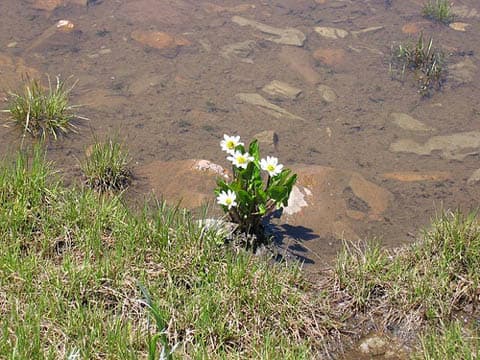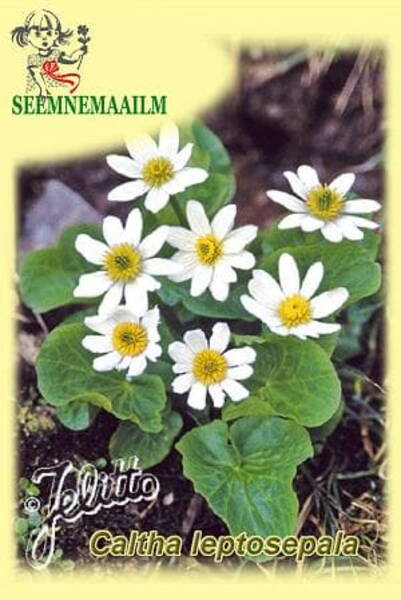Your shopping cart is empty!
White marsh marigold
Caltha leptosepala L.
1.42€
Ex Tax: 1.14€
Ex Tax: 1.14€
White marsh marigold - Caltha leptosepala.
Water- or marshplants.
III-IV, Z3-7, 20 cm.
White, often outside bluish.
The increased interest in the landscape style of gardens has forced flower growers to turn their attention to ornamental plants, resistant, easily propagated and not widely distributed in culture. Marsh marigold turned out to be just such a plant, whose exceptional decorative effect, a wide range of individual species, pronounced intraspecific diversity, early maturity and long flowering period make it exceptionally interesting in the design of picturesque areas of the coastal zone of reservoirs.
Flowering period: III-IV.
Climate zone: Z3-7.
Plant height: 20 cm.
1,0 g = 1300 seeds.
Location: requires open places with sufficient moisture (in this case they bloom most abundantly), but they tolerate partial shade and shade.
Soil: Because marsh marigolds naturally grow in damp places, they need rich, well-drained soil. With constant watering, it can also grow in dry places.
Reproduction: freshly harvested seeds ripening in June. When sown immediately after ripening, they germinate at the end of summer, in the case of sowing before winter, seedlings appear in spring. During spring sowing, phased stratification is recommended: about a month at 10 degrees, then two months at 18-20 degrees. Germination occurs at 18-20 degrees. Seedlings bloom in the second or third year. You can propagate Caltha by dividing the bush, preferably in autumn. Can be propagated by cuttings throughout the growing season.
Usage: indispensable near water bodies, in damp places. One of the earliest flowering coastal plants in which the foliage grows and remains quite decorative all summer. When decorating the banks of decorative reservoirs and streams, marigolds can be successfully used, creating juicy bright yellow spots both in clean plantings and in the vicinity of other plants. It is advisable to select species that are combined according to ecological needs, which complement each other in terms of flowering, color of flowering and vegetative plants.

White marsh marigold. Bot. syn.: Caltha biflora DC., Caltha howellii (Huth) Greene, Psychrophila leptosepala (DC.) W.A.Weber.
Water- or marshplants.
III-IV, Z3-7, 20 cm.
White, often outside bluish.
The increased interest in the landscape style of gardens has forced flower growers to turn their attention to ornamental plants, resistant, easily propagated and not widely distributed in culture. Marsh marigold turned out to be just such a plant, whose exceptional decorative effect, a wide range of individual species, pronounced intraspecific diversity, early maturity and long flowering period make it exceptionally interesting in the design of picturesque areas of the coastal zone of reservoirs.
Flowering period: III-IV.
Climate zone: Z3-7.
Plant height: 20 cm.
1,0 g = 1300 seeds.
Location: requires open places with sufficient moisture (in this case they bloom most abundantly), but they tolerate partial shade and shade.
Soil: Because marsh marigolds naturally grow in damp places, they need rich, well-drained soil. With constant watering, it can also grow in dry places.
Reproduction: freshly harvested seeds ripening in June. When sown immediately after ripening, they germinate at the end of summer, in the case of sowing before winter, seedlings appear in spring. During spring sowing, phased stratification is recommended: about a month at 10 degrees, then two months at 18-20 degrees. Germination occurs at 18-20 degrees. Seedlings bloom in the second or third year. You can propagate Caltha by dividing the bush, preferably in autumn. Can be propagated by cuttings throughout the growing season.
Usage: indispensable near water bodies, in damp places. One of the earliest flowering coastal plants in which the foliage grows and remains quite decorative all summer. When decorating the banks of decorative reservoirs and streams, marigolds can be successfully used, creating juicy bright yellow spots both in clean plantings and in the vicinity of other plants. It is advisable to select species that are combined according to ecological needs, which complement each other in terms of flowering, color of flowering and vegetative plants.

White marsh marigold. Bot. syn.: Caltha biflora DC., Caltha howellii (Huth) Greene, Psychrophila leptosepala (DC.) W.A.Weber.












